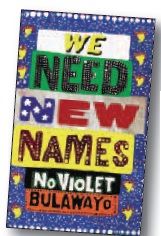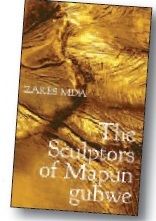Tales From the Limpopo
I have just finished reading two amazing novels, both written on Southern Africa – stories of Africa. Both written by Southern African writers - vastly different in time and in content but largely taking place to the North and South of the Limpopo River.
"We Need New Names" by NoViolet Bulawayo.
First published by Chatto and Windus, Random House, London, 2013.
This is a story of a child of Africa - of her childhood in Zimbabwe, her teenage years in the United States and the lives of illegal immigrants in their new adopted home. I had read very warm words on this book and saw it in a bookshop in Cape Town. The unusual name of the book, of the author and the highly decorative cover caught my attention and I bought it. This purchase took me through a powerful reading experience. The first half is told by and through the eyes of a ten-year old girl-child growing up in a make-shift refugee shanty town in the trouble-torn country of Zimbabwe. Their lives, their land, their homes were torn apart and taken from them, first by white settlers and then by the power struggle of their own people. The language is that of a child, spoken in English, a tongue not her own, which is charming and full of humor. At first it would seem as if it is a book for children. But not so, for the story it tells is both tragic and brutal. The children roam the streets. There is no school as the teachers, like so many others, have left for other countries near and far in the hope of finding a better life and food to eat. Most of the men, the few who still remain, sit and talk as there is no work. The women – those wonderful women, as in so many places - are those who fight to keep their families and children surviving and functioning. Amazing and colorful characters are brought into the pages with tales of "beauty and horror, laughter and pain". We follow the children through the dusty rubble-ridden lanes to discover a wide spectrum of the life around them. We follow them into a more prosperous neighborhood – probably a white neighborhood - where they steal fruit, both for fun but mostly to eat. Hunger dominates their lives. A savage sequence of events follow to further destroy any vestige of community life. Somehow the children remain fun-loving, yearning for friends and play.
Our little girl manages to get to an aunt in Detroit in America and here she tells the perhaps more comfortable, certainly less hungry life of a teenager growing up in an African immigrant's home in America. There is food, a home, school, friends but so different from the life she knew. Here we read of the huge cultural gap such people need to face. The longing for family, friends, the culture and life left behind – probably never to be seen again, shadows all. But there are very few who would be prepared to go back to that life of hunger and dire poverty. Our child grows and goes into the world of work and survival as an immigrant – an illegal immigrant. She is amongst thousands of such people from dozens of countries – their names difficult to pronounce and remember – they call each other by the names of the country they come from - China, Nigeria, Mexico and on and on. There is a whole chapter on the condition of these immigrant workers who keep the wheels oiled in America and indeed throughout the world. The chapter is most powerful and deeply moving. It had me completely riveted. Is this the slavery of the modern world?
A book well worth reading, it has been shortlisted for The Man Booker Prize.
The Sculptors of Mapungubwe by Zakes Mda.
Published by Kwela Books SA 2013
A story and beliefs, the clothes and the art, the sculpture. Clearly the author, also an artist, must combine mysticism and reality; history and legend. The setting – near The Limpopo in the 13thcentury in tribal Africa – governed by the traditions, superstitions, their Gods have seen some of the remains of such art from those times and places.
This is the story of a man, Chata, from a village, Mapungubwe, not far from the Limpopo River in the year 1223 CE. 'It was common knowledge that his mother was a !Kung woman, cave dwellers named Zhun/Twasi which meant "real people". People from the South – I think akin to the Bushmen of the Kalahari Desert. From her he learned to hunt while respecting the lives of the animals, to live off the earth. People with magic powers of the Trance – a trait which brought awe to the local villagers although these !Khun were despised as wanderers who owned no land. From his father, a black man of high status in the village, he inherited and learned to be a master artist – a sculptor. His art was also strongly influenced by his mother's people. When our man is attacked by "wanderlust', or 'mitshimbilo,' the disease of the wanderers, we go with him north, crossing rivers through African land, meeting the different people and their ways as far as the Swahili coast. From there comes a voyage with Arab traders to Lebanon. On his return, adventures – pirates, slavery, meeting with Pygmies and description of the vastly differing terrains of Africa. Then, his return to the village, his sculpture, his search for gold and a love story with a beautiful dancer who brings rain to the village and joy to his life.
Read this amazing book – yet another work of art by Zakes Mda.










Comments